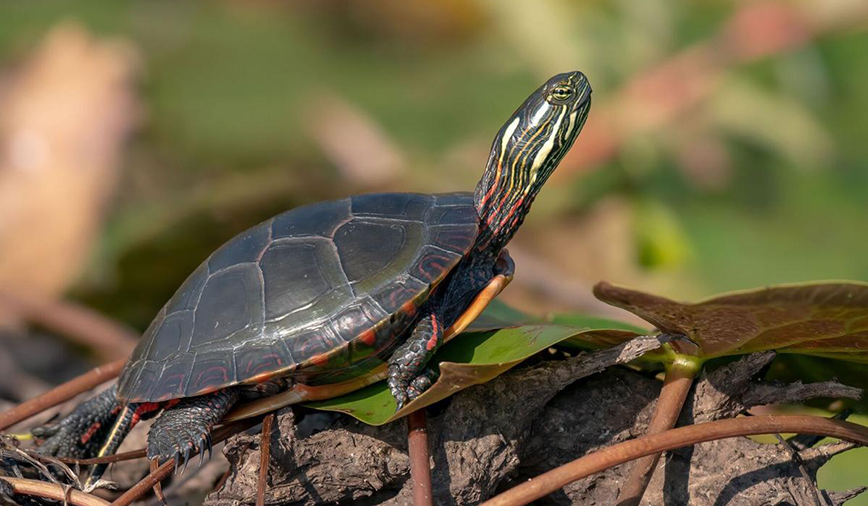February 27, 2015
Bird Tracks
A female midland painted turtle, Chrysemys picta marginata, showed up unexpectedly last week in the Hickory Knolls turtle pond, threatening the well-being of the endangered Blanding’s turtles that reside there.
I’m not gonna lie, we like to have fun here at the ‘Knolls.
Even though the duties can be demanding and the hours long, we still find ways to amuse ourselves over the course of our work week. We surprise each other with little gifts, like Tootsie Rolls twisted into edible “scat.”
Our desks are decorated with insect exoskeletons, tree cookies and rocks; we even share amongst ourselves a swatch of “real” Sasquatch fur. (In fact, it was such a hit, we created a special event celebrating it. Mark your calendars now for Gone Squatchin’ 2015, to be held Saturday October 3, 5 to 7 p.m., here at Hickory Knolls.)
But the other day—last Friday the 17th, to be exact–we found ourselves engaged in a game we really wished we didn’t have to play.
If you’ve ever watched the children’s show Sesame Street, you’re probably familiar with One of These Things Is Not Like the Others. The segment, complete with its own song that tends to repeat, over and over, in your head, challenges viewers to spot the one item in a group that is different from all the rest. Some Sesame Street versions have included three big shoes and one little one; three starfish and one crab; and three pigs and Kermit the Frog.
Our Hickory Knolls version, completely unplanned on our part, consisted of seven Blanding’s turtles, and one painted turtle.
If you’ve ever been to our building, you know that the lobby features a 500-gallon turtle pond that is home to several large Blanding’s. Endangered in Illinois, Emydoidea blandingii is in the midst of a recovery program that includes the establishment of a captive breeding population. The turtles in our pond are part of that effort, spearheaded by ecologist Dan Thompson of the Forest Preserve District of DuPage County, and come and go as the project’s needs dictate.
Over the years we’ve done everything we can to foster the Blanding’s wellbeing. Handling is minimized. Water quality is regularly monitored. Nonnative species, like the plecostomus , a giant, sucker-mouthed catfish I thought might help keep the pond clean, are discouraged. And other kinds of turtles, due to the high likelihood that their gut fauna may carry microorganisms that could make the Blanding’s sick, are strictly forbidden.
So we were quite taken aback when, on that Friday, we discovered that the turtle pond had acquired some unwanted diversity.
I was speaking with a father and son, who’d stopped by to tell us about the turtle rescue they’d recently conducted. The father was hopeful that they’d done the right thing by getting the animal off the road and, moving it in the direction its head was pointing, taken it to a nearby pond.
As the two told their story, Dad mentioned that they were curious as to what kind of turtle it was they had found. He gestured toward our pond and said, “It’s like the one you guys have.”
My heart skipped a beat before I blurted, “Holy cow! You found a Blanding’s?!”
The dad hesitated a bit before responding, “Well… it’s like the one you have with the stripes on its neck, and the red pattern around the edge of its shell.”
My brain was unsure of how to process this new information. One of the Blanding’s distinguishing features is a bright yellow neck, with nary a stripe to be found. And their dark shells, while patterned with light-colored spots and streaks, have not one speck of red anywhere.
I had a hunch of what had happened but needed further proof, so over to the pond we went. And, sure enough, peeking out from under a ledge, was a good-sized female Chrysemys picta—a painted turtle.
As she pushed away from the edge and paddled lazily around the pond, it was pretty clear that she was used to being around humans. Heck, she may even have thought that we had come over to feed her.
Her eyes were clear; her colors vivid. And her shell was in great shape, save for one good-sized ding—an injury that had healed. Although we have little hope of figuring out where she came from (though we did find a blue shoe box in a trash can the next day) we may be able to piece together our newcomer’s story.
Perhaps she was found injured, then nursed back to health. Maybe she then grew too large for her enclosure. Or was thought to require too much care. At any rate, she’s in our pond now, and not likely to leave.
After a discussion with Dan Thompson, it was decided this Ms. Picta can stay, as long as she does not display any signs of aggression toward the Blanding’s, nor them toward her. We’ll also be on the lookout for any signs of illness among the Blanding’s.
As they say, so far, so good. But as a staff, we have made it a priority to step up our vigilance, to try and keep the turtle pond protected from any other unwanted guests. We’ll have fun with it, because that’s how we roll. But we won’t be slacking off. Because, honestly, the last game we want to be playing is Two of These Are Not Like the Others.
Pam Erickson Otto is the manager of nature programs and interpretive services at the Hickory Knolls Discovery Center, a facility of the St. Charles Park District. She can be reached at 630-513-4346 or potto@stcparks.org.

